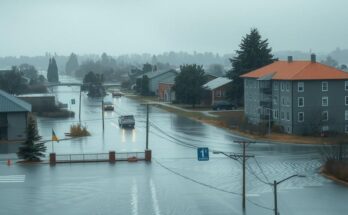An Arctic outbreak is bringing extreme cold temperatures to Eastern Canada and the U.S., with lows dropping below -17°C in major cities like Philadelphia and Washington, D.C. Areas in the Kitikmeot experienced chilling temperatures below -30°C. Meteorologist Brian Proctor indicates temperatures may stabilize by next week. Arctic outbreaks are common, but historic precedents illustrate their potential dangers.
The onset of the New Year brings with it an Arctic chill sweeping through North America, particularly affecting Eastern Canada and the United States. This severe drop in temperature is attributed to an Arctic outbreak originating from Siberia, as explained by meteorologists at the U.S. National Weather Service and Environment Canada. Cold air masses have moved across the North Pole, descending through Alaska and northern Canada, ultimately reaching southern areas, including Florida.
Currently, communities in the Kitikmeot region are facing extremely low temperatures, plunging below -30°C, with wind chills potentially dipping to an alarming -50°C. Iqaluit, which has previously enjoyed relatively mild conditions, is forecasted to experience a significant temperature decline to -17°C by January 8. In Eastern Canada, the temperature is anticipated to decrease from -1°C to -11°C, signaling a notable chill.
While some regions may not experience extreme cold compared to historical averages, areas along the East Coast of the United States will encounter especially harsh conditions. Philadelphia, Pennsylvania, is predicted to see temperatures plummet to below -17°C, marking a record low for the century. Washington, D.C. is also expected to experience similar historical lows not seen since 2019. Meteorologist Brian Proctor indicates that a warming trend may commence toward the end of the following week.
Arctic outbreaks are a common occurrence during winter months, yet the severity of the 2019 outbreak remains a stark reminder of the risks involved, resulting in over 20 fatalities and significant disruptions to transportation due to extreme wind chills. The current conditions serve as a critical warning for residents across affected areas, underscoring the importance of preparedness during such extreme weather events.
The Arctic outbreak phenomenon occurs when severe cold air masses from the Arctic regions, particularly Siberia, travel across the North Pole and into different geographical areas, affecting climate conditions significantly. This phenomenon occurs most frequently during the winter months and carries adverse effects, including extreme temperature drops. An example of its impact can be seen in January 2019 when the U.S. experienced a particularly devastating Arctic blast, resulting in numerous fatalities and widespread flight cancellations. Understanding these processes allows meteorologists to predict and communicate the effects of such weather patterns effectively.
In summary, the Arctic outbreak currently affecting North America serves as a reminder of the severe weather conditions synonymous with winter, with temperatures expected to drop dramatically across Eastern Canada and the eastern United States. With forecasts predicting extreme conditions unprecedented for many areas, it is essential for residents to stay informed and prepared. This weather phenomenon, while recurrent, presents significant risks and highlights the importance of monitoring climate changes during winter seasons.
Original Source: nunatsiaq.com




